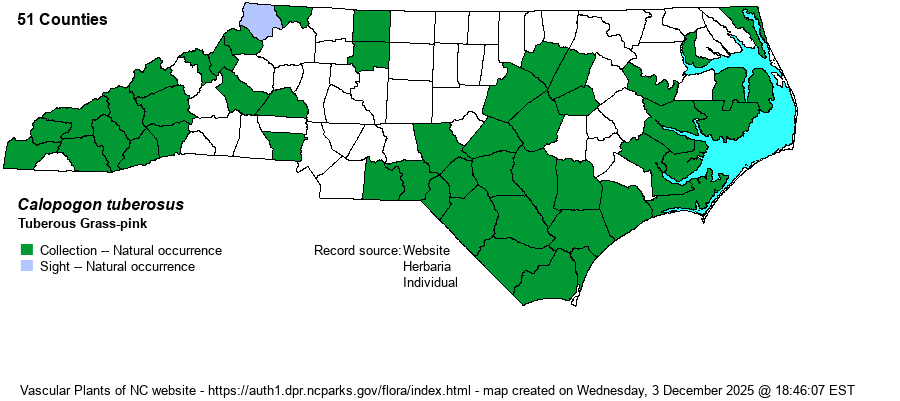| Author | (L.) Britton, Sterns, & Poggenburg | |
| Distribution | Present over most of the southern and central Coastal Plain, but few records for the northern counties, despite many records from eastern VA. It also occurs over most of the Mountains, with only a very few scattered records for the central/western Piedmont. Nearly absent from the Piedmont.
Unlike all other Calopogon species, this one ranges across all of the Eastern US and southern Canada, south to the Gulf Coast. However, it is very scarce in the Piedmont province, and in much of the area west of central TN and central KY. | |
| Abundance | Fairly common, at least locally, in the southern Coastal Plain; uncommon to fairly common locally in the Sandhills and central Coastal Plain, but very rare in counties toward VA. In the southern Mountains, is it rare to uncommon, but it is rare in the central and northern Mountains, and very rare to absent in the Piedmont. | |
| Habitat | In the Coastal Plain, it favors pine savannas, wet pine flatwoods, sandhill seeps, streamhead ecotones, and other damp and sunny spots, but usually associated with Longleaf (Pinus palustris) or Pond (P. serotina) pines. In the Mountains and part of the Piedmont it is limited mainly to bogs and rarely in wet meadows. |
| Phenology | Blooms from April to July, and fruits from July to September. | |
| Identification | This is the most robust of the four Calopogon species in NC, typically growing from 1-2 feet tall, rarely taller. The raceme consists of 4-20 large, rose-colored (to pinkish-rose) flowers, each about 1.5 inches across, considerably larger than on other grass-pinks. The flowers are spaced well apart and bloom singly, starting from the bottom, such that at any given time only a few will be in bloom. In all Calopogon species, the flowers are "twisted" upside down, such that the lip is the colored floral part at the top, and the colored sepals and petals are at the bottom and sides. All other orchids have the flower's lip at the bottom, like a "tongue" hanging out of a mouth or tube. This is, by far, the most widespread grass-pink in the state, though in Coastal Plain savannas the Pale Grass-pink (C. pallidus) often equals it in numbers. It can often be one of the first orchids seen in a savanna walk, as well as in a bog walk in the mountains. | |
| Taxonomic Comments | Older references, including RAB (1968), named the species as C. pulchellus; nearly all more recent references use C. tuberosus. Also, many references have varieties listed for it, not surprising given its large range. The form in NC is the nominate one -- C. tuberosus var. tuberosus.
| |
| Other Common Name(s) | | |
| State Rank | S3 [S4] | |
| Global Rank | G5 | |
| State Status | | |
| US Status | | |
| USACE-agcp | OBL link |
| USACE-emp | FACW link |

